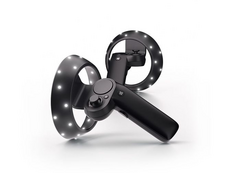Windows Mixed Reality Motion Controllers
| Developer | Microsoft |
| Requires | Windows Mixed Reality Headsets |
| Operating System | Windows |
| Image | |
| Optics | |
| Tracking | 6DOF |
| Rotational Tracking | IMUs |
| Positional Tracking | Camera on headset |
| Input | trackpad, thumbstick, trigger, grip button, buttons |
The Windows Mixed Reality Motion Controllers (Figure 1) are Input gadgets for the Windows 10 VR Headsets also known as Windows Mixed Reality Headsets[1]. In order to increase the sense of immersion in the VR experience, good controllers are essential. Both the Oculus Rift and the HTC Vive have a pair of motion controllers [2].
According to Microsoft, “Motion controllers are hardware accessories that allow users to take action in mixed reality. An advantage of motion controllers over gestures is that the controllers have a precise position in space, allowing for fine-grained interaction with digital objects. For Windows Mixed Reality immersive headsets, motion controllers are the primary way that users will take action in their world.” [1]
These motion controllers are essential for Microsoft in order for people to take their new venture into mixed reality seriously - a blending of the physical world and the digital world. Before the announcement of the Windows mixed reality controllers, the only way to interact with the mixed reality platform was a Xbox controller. Indeed, many cited that the lack of a dedicated motion controller was a deficit in the new Windows 10 platform [3].
Announcement[edit]
The announcement of the first Windows mixed reality controllers was made at Microsoft’s Build conference, in May 2017. The controllers are said to work without external tracking sensors, featuring responsive tracking and six degrees of freedom, and will be compatible with a line of dedicated VR headsets from Microsoft’s partners like Acer, Asus, Dell, HP, and Lenovo [2][4][5].
The controllers are planned to release at the end of 2017 [4].
Mixed reality controllers and VR headsets[edit]
Microsoft said that the controllers will aim for easy-to-use setup, just like the VR headsets. They will be sold alongside several different Windows VR headsets. It has been confirmed that Acer’s VR headset and controllers will be available as a bundle (Figure 2), costing $399 [2].
At first glance, the controllers have a similar look to the Oculus Touch and Vive controllers. They have a thumb stick like the Oculus Touch, a touchpad like the Vive, and a wand-like design with a tracking ring on the end [2]. According to a CNET report, the controllers will not work with HoloLens [6].
Following the same strategy as with the VR headsets, Microsoft sets the Windows mixed reality specifications so that apps and games work similarly with all the headsets and controllers and the company’s partners are responsible for manufacturing and differentiating their products [3][4].
There have been some complaints from some experienced VR users regarding the mixed reality controllers. A common issue was that “due to the optical tracking using cameras in the headset the technology would not be able to track your hands accurately if you look over your shoulder for example or sweep them behind your back.” While the controllers have an inertial measurement unit and use inverse kinetics to compensate for when they’re not in the camera’s view, this is not as accurate as the optimal tracking [3].
Features[edit]
The Windows mixed reality controllers will offer precise and responsive six degrees of freedom tacking of movement in the field of view using the sensors in the headset. There will be no need for external sensors on the walls for the controllers to work [1][3][6].
The controllers will have optical tracking, a Trigger, a grab button, a thumbstick, and a touchpad [1].
Gazing and pointing[edit]
There are two key models for interaction with the mixed reality controllers: gaze and commit and point and commit.
Gaze and commit - users target an object with their gaze and then use select interactions.
Point and commit - users can aim a pointing-capable motion controller at the target object and use select interactions [1].
References[edit]
- ↑ 1.0 1.1 1.2 1.3 1.4 Microsoft. Motion Controllers. Retrieved from https://developer.microsoft.com/en-us/windows/mixed-reality/motion_controllers
- ↑ 2.0 2.1 2.2 2.3 Stein, S. (2017). Microsoft unveils its own motion controllers for Windows 10 VR. Retrieved from https://www.cnet.com/news/microsoft-making-its-own-motion-controllers-with-windows-10-vr-mixed-reality-acer
- ↑ 3.0 3.1 3.2 3.3 Surur (2017). A closer look at Microsoft’s Windows Mixed Reality Motion Controllers (video). Retrieved from https://mspoweruser.com/a-closer-look-at-microsofts-windows-mixed-reality-motion-controllers/
- ↑ 4.0 4.1 4.2 Protalinski, E. (2017). Microsoft unveils Windows Mixed Reality motion controllers, Acer promises VR bundle for $399 ‘this holiday’. Retrieved from https://venturebeat.com/2017/05/11/microsoft-unveils-windows-mixed-reality-motion-controllers-acer-promises-vr-bundle-for-399-this-holiday/
- ↑ Hardawar, D. (2017). Microsoft unveils Windows Mixed Reality Controllers. Retrieved from https://www.engadget.com/2017/05/11/microsoft-unveils-windows-mixed-reality-controllers/
- ↑ 6.0 6.1 Nunez, M. (2017). Microsoft’s new mixed reality controllers look very familiar. Retrieved from http://gizmodo.com/microsofts-new-mixed-reality-controllers-look-very-fami-1795127966

